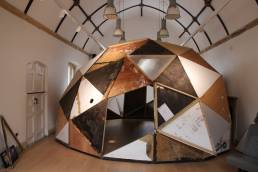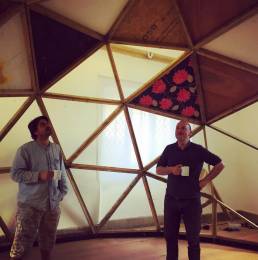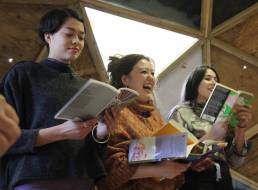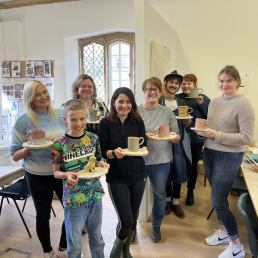In 1965 Gene Bernofsky, Jo Ann Bernofsky and Clark Richet graduates of the University of Kansas desired to live and work together free from the hierarchies and restrictions of mainstream life so moved to a plot of land near Trinidad Colorado and built an experimental settlement they named ‘Drop City.’ Their aim was for the site to be an environmental research centre a collaborative space for artists inventors free-‐thinkers and collectives who wished to celebrate creative experimentation; for people they described as ‘Droppers’. Bernofsky commented that ‘in the old days it was the Gold Rush that had brought people together but now people come together looking for the true life.’ For the ‘Droppers’ establishing a non-hierarchical community openly sharing ideas collectively living and working together was seen as the embodiment of this idea of the ‘true life.’
50 years on do the Droppers thoughts and ideals still have relevance? What might the idea of the ‘true life’ mean today? In what ways might we still be looking for the true life? Collaborative artist’s Ray and Webster propose to explore these questions in their project ‘Dropper’s.’
Counter Culture Drop In – e-zine by Stuart Blackmore
OSR Projects Lobster Trap commission 2016
OSR Project Space, Church Street, West Coker, Somerset
16 April – 8 May 2016

Droppers – film by Amanda Walsh/Pandamedia Cornwall ( 5:18 mins)

Andy Webster
Born in Mansfield, UK, Andy has a doctorate in Fine Art practice awarded by the University of Arts, London, MA Fine Art from the University of Brighton, and BA Fine Art awarded by Manchester Metropolitan University. He works individually and collaboratively across sculpture, performance, moving image, sound and curatorial practice often in response to the characteristics, approaches, attitudes and metaphors associated with a particular site, context, or discourse. He has been the recipient of awards.
https://andy-webster.format.com/shelley#0
Darren Ray
Born in Redruth, UK, Darren has a BA (Hons) Fine Art from Falmouth University. He works across sculpture, performance, and moving image.
https://www.darrenray.co.uk

Droppers – Review by Maddy Hearn
Stacked, mind-expanding books grow into impromptu plinths for baguette slices… read Maddy Hearns review of Andy Webster & Darren Ray’s Droppers exhibition that took place at OSR Project Space in West Coker during April & May 2016
Maddy Hearn is and Artist, educator & writer. She makes collaged books, page-works, weeny videos and object arrangements. Tweets and Instagrams @maddyxhearn
Droppers.
Recipients of OSR Projects’ Lobster Trap Commission, Andy Webster and Darren Ray worked collaboratively to replicate a Droppers’ geodesic dome within OSR’s Project Space at West Coker, Somerset. Immersed in Droppers’ collective spirit, Ray and Webster examine the potential relevance of Drop City qualities and counter-culture activities and consider what the contemporary embodiment of this might be.
The artists’ dome defines a social environment for a series of ‘drop in’ events: performances, readings, music and food; exploring collaboration, collectivity and counter-culture. While the structure is dominant within the exhibition environment, resourced areas around the dome provide a range of texts contextualizing Droppers. Libraries of books, films and music spanning design, economics, the hippie movement, beat epoch, mind expanding enquiry and psychedelic experience provide rich research content. The exhibition feels like an active learning project and embraces pragmatic, messy discovery. Drop-ins are social by nature and enable conversation. In this environment it’s easy to make friends and learn more about the Dropper movement through the resources, activities, materials and social structure that make up the geodesic dome.
Drop City, emblematic of growing anti-establishment sub-cultures developed into one of the earliest hippy communities in the United States. Richard Buckminster Fuller’s vision to re-invent the world through designing life beneficial schemes provoked a group of graduates in 1960s Colorado to participate in experimental communal living. Droppers; free-thinking artists, collectives, and inventors occupied Bucky motivated geodesic domes. Constructed of sequential triangular shaped panels, geodesic structures remain ultimate formations for structural rigidity based on principles of tension. Drop City’s curved shelters improvised with salvaged dumped materials formed spherical networked dwellings where Droppers co-existed for 7 years.
Reclaimed wood batons screwed together, shape the robust geodesic framework of Ray and Webster’s dome at OSR. Repurposed materials are cut to shape and hammered down to each triangular frame – a patchwork of sorts. Particleboard; plywood; roofing panels; fiberboard; wall panels; corrugated plastic and colourful car bonnets form clunky, multi-textured geodesic paths.
Noticeably, several panels suspend assorted household facades: beige granite effect Formica work surface; gloomy asphalt shed roofing and lurid black modern wallpaper fusses over huge, pink, puffy, flower motifs.
Bonnets collected from scrapyards chronicle dents, dirt and scrapes of bygone motoring predicaments; these metallic stories are hammered down to the exterior dome shell. One derelict Renault logo punctuates this outer structure, vaguely beaming global-conglomerate shine.
Within the project space, free credits incite tiny acts of civil disobedience on the outmoded jukebox; CD index cards substituted with crude geodesic drawings and a felt tipped interpretation of ‘Dr. Brian May as animal’ are flicked through. Sunshine yellow, origami geodesic models appreciating Bucky’s published diagrams scatter the library. Skew-whiff cocktail stick and Plasticine geodesic models hang out on a windowsill evidencing workshop activity. Manual and electric hand tools, toolboxes and spare cut panels are dotted around the constantly evolving space.
Passing inside the dome through a low triangular doorway, participants slowly unfold blankets and lay them down observing Alison Knowles’ 1979 instructional performance ‘Unfurl’. Knowles’ score posted to Ray and Webster by Clare Thornton was to be opened, read and completed by the audience during the event. Blankets: synthetic, plush velour and time-honoured felts in mottled purple, blues and greys render warm comfort for occupying the dome floor.
The interior shell reveals the other side of the car bonnet panels hammered to the wooden geodesic framework. Here, the hidden sides of car manufacturing processes are presented; mastic globules, forged die-cuts and acid-color car paints chart original factory fits and retrospective spray jobs.
The dome stands tech-ready for amplified readings and performances. Wooden batons take the shape of a wonky, three-legged microphone stand secured honestly with black, scrim-backed, polythene duct tape. Shiny, buff, pressure-sensitive parcel tape secures a microphone coupled with a cute mini-amp popped on a crude particleboard lectern. Channelling rubbish Hollywood pizzazz, the lectern flaunts an Art Deco-ish fanning of geometric wood panels. Rad, acid-coloured tween-age skater stickers plaster the happy little amp.
Participants assemble as itinerant reading groups, cross-legged on the blankets. Books gathered from the library pepper the unfurled felts within the dome. Simon Lee Dicker’s delicious ‘car boot soup’ is shared beside carved slantways baguette. Stacked, mind-expanding books grow into impromptu plinths for baguette slices. Bikes, camper vans and four-stroke cylinder engines are the hot topics accompanying soup-slurping and clinking soupspoons.
In the spirit of Droppers, people ‘drop in’ and out of the dome as performances and readings unfold throughout the afternoon. Readings from phones, books, notebooks, self generated books, home-spun songs of ecology, skills sharing enquiry, discussion captured by twin typewriters and the arrival of a big fluffy dog called Curly Wurly.
Noticeably, a contemporary paragon of Droppers’ spirit might very well describe Keiken Collective. Keiken’s playful intervention invited visitors to ‘wear clothes inside out’ by means of handwritten instructions slipped into the internal framework of the dome. For Keiken, wearing their clothes inside out provided them with a ‘uniform’ during the day to be expanded and available to everyone. Gradual waves of participation from Keiken’s invitation followed. Jeans, dresses, jumpers, shirts, dungarees, T Shirts and cardigans progressively turned inside out. Surface patterns reversed, over-lock stitching apparent, seams presented the traces of garment construction normally unseen, prominent pockets showed radical functionality. Labels flopped and dangled consumer choice: Marks & Spencer, Zara, TopMan, H&M. En vogue. Derelicte.
In a funny play of words, through facilitating a ‘drop in’ Ray and Webster have created a friendly exhibition, library and series of events enabling participants to examine what it is to ‘drop out’. Given the choice, freedom, skills and privilege; to drop out is to cease participation. Dropping out enables participation to shift from one system to an alternative: to drop in.
Droppers – Andy Webster & Darren Ray, an OSR Projects Lobster Trap commission. The exhibition took place at OSR Project Space, West Coker, Somerset, 16th April – 8th May 2016.
Maddy Hearn is an artist, educator and writer based in South West England. She makes collaged books, page-works, weeny videos and object arrangements. Tweets and Instagrams @maddyxhearn


